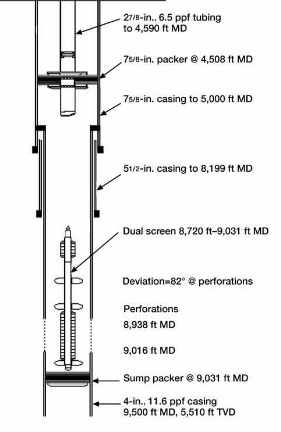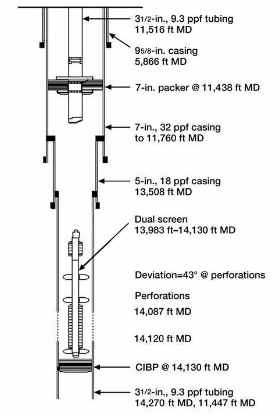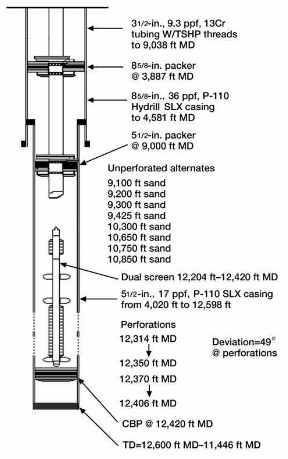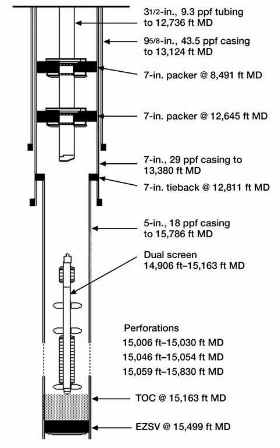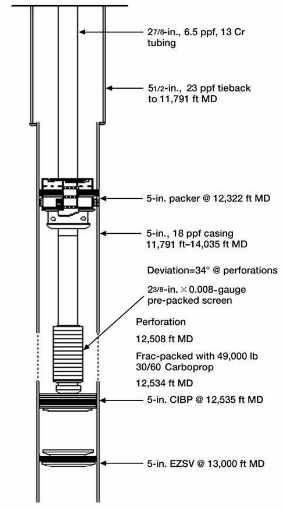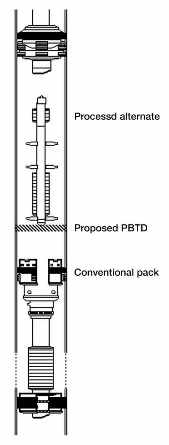Rigless frac packs provide cost-effective completions
Rigless frac packs provide cost-effective completionsResults are helping to lessen prior concerns about flowrates through smaller gravel pack screens. This could lead to more monobore completions in wells where sand control is an issueCharles Ebinger, Completion Engineers, Lafayette, La.
In other cases, the operator wanted to set up the well to allow completing in a number of zones by progressively moving up the hole, but without the necessity of mobilizing a rig. These wells had the production packer set above all of the possible completions, and the technique is similar to monobore applications used throughout the world. Both the dual-screen and regular-sized-screen technique (as described in a World Oil, April 1996 article) have been applied to the wells described in this article. In addition, a batch drilling / batch completion procedure is covered, including current economics of the possible savings. Dual-Screen Applications Dual screen is a generic term for a small diameter, closed cylinder device that has gravel pack screen of the required length, a section of blank and a vent screen above. This assembly usually has a bull plug on bottom and a hook-up nipple on top, which allows for separation from the coiled tubing when deployed on bottom. A minimum of 30 ft of blank is recommended, and the vent screen normally is 5 to 10 ft long. Retractable bow centralizers are run on the assembly to provide clearance for the annular pack. After performing a dual-screen frac pack, a series of restress injections are done to help tighten the annular pack. After the restress, coiled tubing is run and the remaining slurry / proppant is washed out down to the top of the vent screen. The well is then flowed, or jetted in, to production or well test. Flow from the zone enters the production screen, up the closed cylinder, out the vent screen and up the production tubing. An operator in Vermilion Block 380 of the Gulf of Mexico encountered two different well situations that required small-diameter casing / liners. In the first case (Fig. 1), a 5-1/2-in. liner was stuck 1,300 ft from bottom while running in the hole. The operator decided to drill out the shoe in the 5-1/2-in. liner, go back to bottom, condition the mud, and run and cement a 4-in., 11.6-ppf liner to TD. This liner was tied back up to the 7-5/8-in. casing at 5,000 ft MD. The 11.4-ppg mud was displaced with 11.4-ppg CaCl2. Due to the 80° wellbore deviation, a 1-1/4-in. coiled tubing memory log was run to correlate with the open hole log.
The sump packer was set at 9,031 ft MD, and the well was perforated TCP with 6 spf. A centralized, dual-screen assembly was placed on top of the sump packer, and the well was frac packed down the production tubing. The well was washed out with coiled tubing to the top of the vent screen. Coiled tubing was tripped out of the hole, and the well flowed at over 900 bopd. This well has a cumulative production of over 145,000 bbl of oil since completion. This same operator recently drilled a well (Fig. 2) in the same field, and due to the well situation, had to set a 5-in., 18-ppf liner at 13,200 ft MD, with possible producing sands below the 5-in. liner. A 3-1/2-in., 9.3-ppf liner was run to a TD of 14,700 ft MD in a 43° deviation. Drilling mud was displaced with 15.6-ppg zinc bromide due to the high BHP of the formation. The well was perforated with coiled tubing-deployed TCP guns with 4 spf.
The dual screen was placed in the hole on top of a bridge plug at 14,130 ft MD. The well was then frac packed, and after the gel broke, slick line was run to determine the amount of proppant on top of the vent screen. Due to the high reservoir pressure, coupled with an 8.5-ppg displacing fluid on the frac pack, a decision was made to flow the well without washing out with coiled tubing. The well flowed initially at 8 to 9 MMcfd with 600 bcpd. The operator intends to increase these rates slowly. This operator has performed two other dual-screen, rigless frac packs in West Cameron Blocks 315 and 317 with sustained production rates of 5 MMcfd and 7 MMcfd. The West Cameron Block 315 well has two more sands below the end of the tubing, and these zones are planned for dual-screen frac packs. On both wells, the dual-screen assembly was placed in the hole with electric line. A new well in South Marsh Island Block 66 is to be completed with a dual screen, using a lift boat for coiled tubing and wireline operations. An integrated group of major service companies performed dual-screen, rigless frac pack procedures on two wells in West Cameron Block 17 field. One well has a 5-1/2-in., 17-ppf liner set to 12,598 ft MD with 3-1/2-in., 9.3-ppf Cr tubing to 9,020 ft EOT, with a production packer at 9,000 ft. This well has nine sands below the EOT. The lowest sand was frac packed with a dual screen and produced at a sustained rate of 20 MMcfd until depletion, with a cumulative production of over 5 Bcf. The other well, with a permeability of 1 md, was frac packed with a dual screen at 15,163 ft. It produced at a rate of 5 to 6 MMcfd, with a cumulative production of 2 Bcf to date, Figs. 3 and 4.
Some operators feel that cement, resin or a mechanical cap on top of the annular pack is necessary. The wells listed in this article did not have any type of annular top, but relied on Darcy’s Law to prevent annular flow. These wells include highly deviated wellbores and very high producing rates of both oil and natural gas. Frac Packs Using Releaseable TCP Guns A completion is planned on an offshore well in the Gulf of Mexico using a new "one-trip" tubing-conveyed perforating system in conjunction with a dual-screen frac pack. The TCP guns, with the dual-screen / blank assembly attached, is run in the hole and positioned with a depth verification tool on a workstring. The tubing and production packer are then run, the packer is set and the wellhead is nippled up. The rig then can be released. The TCP guns are fired by pressuring up at the surface. The guns will fall into the rathole, and the dual-screen assembly moves downward into place. The frac pack is performed down the production tubing using a wellhead isolation tool / treesaver. In this well, an attempt to flow the excess proppant above the vent screen is planned due to the high reservoir pressure. In other cases, it may be necessary to utilize coiled tubing to wash out to the vent screen. The primary reason for using this technique on the subject well is to eliminate the need for high-density completion fluid and a 15,000-psi BOP stack. Also, because producing rates in excess of 25 MMcfd are expected from this well, a larger-sized, dual-screen assembly is planned. This is possible because the screen BHA will be place in the hole prior to running production tubing. Packs With Full-Sized Screens For rigless frac packs with full-sized screens, the screens and blanks are sized as they would be for a conventional completion. The differences are that the bottomhole assembly is run on production tubing with a hydraulic-set production packer. A frac port or sleeve is run at the top of the assembly, below the production packer. The well is nippled up, tree set and tested and the rig moved off the well. The inside of the screen, and some portion of the blank, are filled with sand at the surface while running in the hole. Stimulation equipment is mobilized, and a tree saver installed. The frac pack treatment is pumped down the production tubing, with some predetermined pressure put on the backside. After the tip screen-out, a series of restresses are done to ensure a tight annular pack. Coiled tubing then is run in the hole to wash out to the bottom of the screen. A shifting tool on the coiled tubing will close the sleeve / port if the operator feels that it is necessary. In the majority of these completions, the sleeve was not closed, instead relying on Darcy’s Law in the annular pack to cause production to go through the screen and up the production tubing. A platform well in Matagorda Island Block 665 was recompleted in a 2,000-ft gas sand with a rigless frac pack in early 1997. Original wellbore equipment was removed using a snubbing unit, the new gravel pack assembly was run on production tubing, the production packer set and the tree was installed. The snubbing unit was rigged down, the zone frac packed and coiled tubing was used to wash out excess proppant. The initial producing rate was more than 4 MMcfd, and to date, the well has a cumulative production of over 3 Bcf. It still produces more than 1 MMcfd. This economical recompletion was done in an area where offset operators were drilling expensive horizontal wells to the same zone. An operator in Galveston County, Texas, has an ongoing program of installing sand control measures and frac packing zones using the full-sized-screen technique. A recent well was recompleted in another zone, downhole sand control assembly placed in the well, frac packed, cleaned out with coiled tubing and placed on production at 7.5 MMcfd with 6,200 psi FTP. Some additional wells in the field are planned with the same procedure, Fig. 5.
Completing land wells along the Gulf Coast with this technique, where sand control is required, has another advantage. Due to the demand for land fracturing equipment, it is necessary to schedule the equipment on a certain date. However, with the rigless technique, everything can be made ready, with the tree on the well. The rig can be moved off location and the fracturing equipment brought in when available. This type of rigless frac pack procedure allows the use of alternate path technology, or shunt tubes. The results – in completions where there are long intervals or multiple lobes – have proven to show better annular packs using the shunt tubes. The conventionally sized screen and blank also allow access for the running of various logs and tracer surveys. Rigless Batch Drilling, Completions Substantial completion cost reductions can be realized, particularly offshore, when a group of wells is drilled and cased. This procedure involves having the drilling fluid changed out with completion fluid, the well perforated and a gravel pack assembly installed. The gravel pack assembly is run on production tubing with a production packer. The screen is positioned, the packer set and the tree installed. The drilling rig is moved off location. A coiled tubing unit then is mobilized to the platform or a lift boat, and stimulation equipment is mobilized to perform multiple frac packs. Two or more of these treatments can be done in one day, reducing the total cost. Coiled tubing is run in each well to wash out and close the sleeve or frac port. Wells are then put on production or test. Cost savings analyses have been done on a number of proposed projects, where single-zone completions are planned. Cost reductions are possible in the daily rig cost, gravel pack tools, completion fluids and in stimulation boat mobilization and group treatment costs. The estimated reduction in completion costs utilizing this new technique is $210,000 to $215,000 per well. Detailed planning is necessary to accomplish the objective, but the actual implementation of the procedure is not complicated. The key to this technique is that the wells are completed with an equal completion efficiency as a conventional completion. Unlike the dual-screen type technique, full-sized gravel pack screens are used with some minor modifications to the bottomhole assembly. The frac pack procedures do not differ in volumes of proppant, fluid types, calibration tests, etc. This procedure has been utilized successfully on land and inland waters, where savings are not as significant as offshore, but are still very cost effective. Monobore Completions Monobore completions are being used worldwide to reduce drilling and tubular costs. Normally, 2-7/8-in. to 4-1/2-in. tubing / casing is set and cemented. The tree is installed and the drilling rig moved off location. The use of monobore wells in areas where sand control is required has been limited, but with the dual-screen technique, it is now possible. This technique is particularly adaptable in wells with gas sands, or oil wells that do not require artificial lift. In 1997, this technique was used on a well in Sunrise field, Terrebonne Parish, Louisiana. This well was sidetracked and, due to hole problems, a combination of 3-1/2-in., 9.2-ppf and 2-7/8-in., 6.5-ppf tubing / casing was run and cemented. The rig was moved off and barges with wireline, coiled tubing and stimulation equipment were mobilized. The well was perforated, a dual screen deployed and the well was frac packed. This well produced at a rate of 6 MMcfd initially, with cumulative production of over 3 Bcf. The well still produces 2.1 MMcfd.
Alternate Zone Completions In a well that has a zone (or zones) with limited reserves above the primary completion, a dual-screen recompletion can be performed. The lower zone is completed with a conventional frac pack / gravel pack. In the initial completion design, an isolation packer is run above the alternate zones. No production tubing is run between the isolation packer and the lower zone packer. After the primary zone is depleted, a plug is set in the lower packer, the alternate zone perforated through tubing with wireline guns and a dual screen is deployed on a preset bottom opposite the new zone. This zone is then frac packed down the production tubing. Packer movement calculations need to be made prior to the frac pack. Coiled tubing then is used to wash out above the vent screen and the well is put on test or production, Fig. 6. Conclusions Due to recent improvements in oil and natural gas prices, coupled with increased drilling rig rates, operators are turning to cost-effective practices. The rigless type completion described in this article is one way to improve the return on investment. In many cases in the Gulf of Mexico and inland waters, lift boats can be used to perform cost-effective, economical completions. Improvements in coiled tubing equipment, new innovations in downhole tools and simplified techniques that do not reduce completion efficiency are being considered. Actual results using these techniques have helped lessen prior concerns about flow rates through these smaller gravel pack screens. This will also lead to more use of monobore completions in wells where sand control is an issue. It may be possible to further reduce the cost of dual-screen jobs, if the dual-screen assembly can be run in the hole with wireline. Also, in higher bottomhole pressure zones where the proppant top after screen-out or restress is not too high, it may be possible to flow the proppant out of the well. The resulting cost savings of eliminating coiled tubing would be substantial. The problem in using this technique on offshore wells, regarding subsurface
safety valves, has been solved by the installation of wireline-retrievable valves or the use of higher
pressure-rated valves.
Acknowledgments The author thanks the following for their valuable contributions to this article: Tom Lincoln, Paul Southworth and Tom Funchess with Forcenergy, Inc.; Harvey Dupuy with TEPCO Resources, Inc.; Tom Lantz and Jeff Lott with Halliburton Integrated Solutions; Charles Caillet with Phillips Petroleum; Bill Folsom with Taylor Energy; Joe Serio with OSCA; and Ted Latch with Schlumberger Dowell.
|
|||||||||||||||||||||||||

